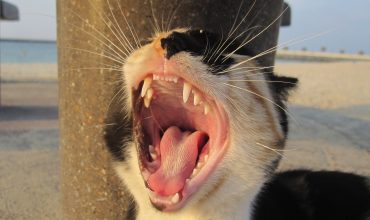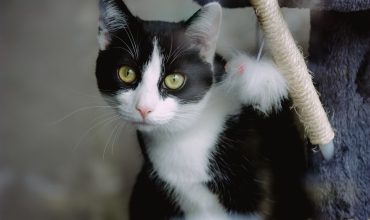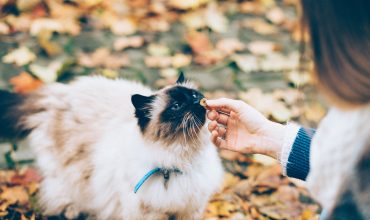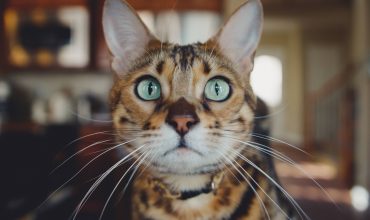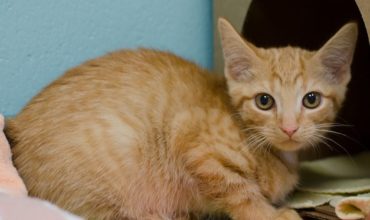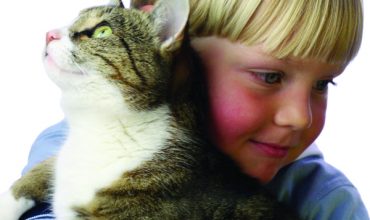[print-me] Living with a pet can be beneficial to children. Pets can enhance a child’s self-esteem, teach them responsibility and help them to learn empathy. However, children and dogs are not always going to automatically start off with a wonderful relationship. Parents must be willing to teach the dog and the child acceptable limits of behavior in order to make their interactions pleasant and safe. Selecting a Dog What age is best? Many people have a “warm fuzzy” image of a puppy and a child growing up together. If you have a young child and are thinking of adopting a
Read More
Archives for Behavior tips
Your Talkative Cat
[print-me] Vocalizing is one way for your cat to communicate with you and with other animals. Some cats “talk” more than others, but most cats do make noise some of the time. We’re all familiar with the meaning of hissing and growling, but there are also many other sounds that your cat is capable of, and a variety of reasons for vocalizing. Medical Reasons If your cat’s behavior changes suddenly, the first thing you should do is take her to your veterinarian for a thorough health examination. Cats often hide symptoms of illness until they’re seriously ill. Any change in
Read More
Declawing Cats
[print-me] Adapted from the MSPCA and revised by the ASPCA’s Companion Animal Services Department The American Society for the Prevention of Cruelty to Animals encourages owners to seek alternatives to declawing their cats. If you are thinking about having your pet declawed, please take a moment to consider the following information. Claws Are Important to a Cat A cat’s remarkable grace and agility and its faultless sense of balance are due to a great extent to its retractable claws, which allow it to establish footing for walking, running, springing, climbing, or stretching. A cat’s claws are also its best defense
Read More
Training Cats with Positive Reinforcement
[print-me] Training your cat has important benefits. You’re stimulating his body and his mind, which helps keep him healthy. And spending time together means you’re strengthening the bond you share. It’s helpful to work with behaviors that are less than desirable and you can also teach fun tricks like wave and fetch, or teach him a range of useful behaviors like sit, stay and to come when called. Reward behaviors that you want Simply put, if you want your cat to repeat a behavior, reward that behavior. It’s important to make sure that you’re rewarding the behavior you want and
Read More
Adopting a Fearful Cat
[print-me] Why Are Some Cats Fearful? Fearful behavior in cats can be caused by various factors. Insufficient exposure to humans and/or a variety of stimuli during kitten hood as well as traumatizing events in their lives can teach them to react fearfully towards people or new situations. Cats can also be genetically predisposed to being fearful. How to Introduce a Fearful Cat to a New Home Fearful cats usually do best in relatively quiet homes. They are often not suitable for young children as children can easily scare them with loud noises or sudden movements. Many fearful cats slowly become
Read More
Petting-Induced or Overstimulation Aggression in Cats
[print-me] Many of us have had the pleasure of petting our cat, when all of a sudden; the cat bites your hand and runs away. This is called petting induced or overstimulation aggression. It’s a common behavior in many cats, and is something that can be both frustrating and frightening until you learn how to manage this behavior with your cat. What causes this behavior? Cats are normally not as social as dogs, nor do they have as much physical contact with others of their species. They may groom each other and sleep close to each other, but have few
Read More
Adopting a Fearful Kitten
[print-me] What Does “Fearful” Mean? A fearful kitten is generally one that has not had full socialization. If a kitten does not have much contact with people when it is between the ages of 3 weeks and 7 weeks, it is likely to be scared of strangers it meets. Depending on the individual temperament of the kitten, what it has observed from its mother, and how old it is, it may hiss, spit or strike out – or may simply attempt to run away. Some fearful kittens learn to trust people quickly, others can take a long time. This depends
Read More
Keeping Cats off of Countertops
[print-me] Why Do Cats Like to Climb? Cats climb for several reasons. They seek out high vantage points, like countertops and shelves, to survey their territory. They can leap onto bookshelves or scale curtains to escape from another household pet or from something that scares them. Tables and the top of the refrigerator often provide warm, sunny places to snooze. Cats can learn to patrol or “surf” countertops, stovetops and tables in search of tasty tidbits left behind. Alternatives to Climbing on Countertops and Tables It’s best not to stifle your cat’s normal jumping and climbing behavior. Your cat will
Read More
Introducing Cats to Children
[print-me] Cats are the most prevalent family pet in the United States and it’s no wonder. They’re quiet and easy to care for—a perfect match for busy families with kids. Raising children with pets provides many benefits. According to the American Academy of Child & Adolescent Psychiatry, pets can: Teach empathy and compassion Provide love, loyalty and affection Foster self esteem Promote physical activity Teach responsibility Provide valuable life lessons Provide a connection to nature What cat lover wouldn’t want to share these wonderful values with their children? Children are naturally drawn to cats, but it’s important to lay some
Read More
Unusual eating habits in dogs and cats
[print-me] Dogs and cats will sometimes eat socks, rocks or other objects, which may result in a variety of problems for both you and your pet. Not only can your possessions be destroyed or damaged, but objects such as clothing and rocks can produce life-threatening blockages in your pet’s intestines. Eating non food items is called pica. A specific type of pic is stool eating (either their own or that of another animal) and, while not necessarily dangerous to the animal, is probably unacceptable to you. Stool eating is called coprophagy. The causes of pica and coprophagy are not known. Many ideas have been proposed by various experts, but none have been proven or disproven. Such behaviors may sometimes be attention-getting behaviors. If engaging in one of these behaviors results in some type of social interaction between the animal and his owner (even a verbal scolding) then the behavior may be reinforced and occur more frequently. These behaviors may be attempts to obtain a necessary nutrient lacking in the diet, although no nutritional studies have ever substantiated this idea. They may also stem from frustration or anxiety. It’s possible behaviors begin as play, as the animal investigates and chews on the objects, then subsequently begins to eat or ingest them. It has been suggested that coprophagy is carried over from the normal parental behavior of ingesting the waste of young offspring. Some experts believe coprophagy occurs more often in animals who live in relatively barren environments, are frequently confined to
Read More





